DODGE DAKOTA 2009 3.G Manual PDF
Manufacturer: DODGE, Model Year: 2009, Model line: DAKOTA, Model: DODGE DAKOTA 2009 3.GPages: 449, PDF Size: 10.96 MB
Page 71 of 449
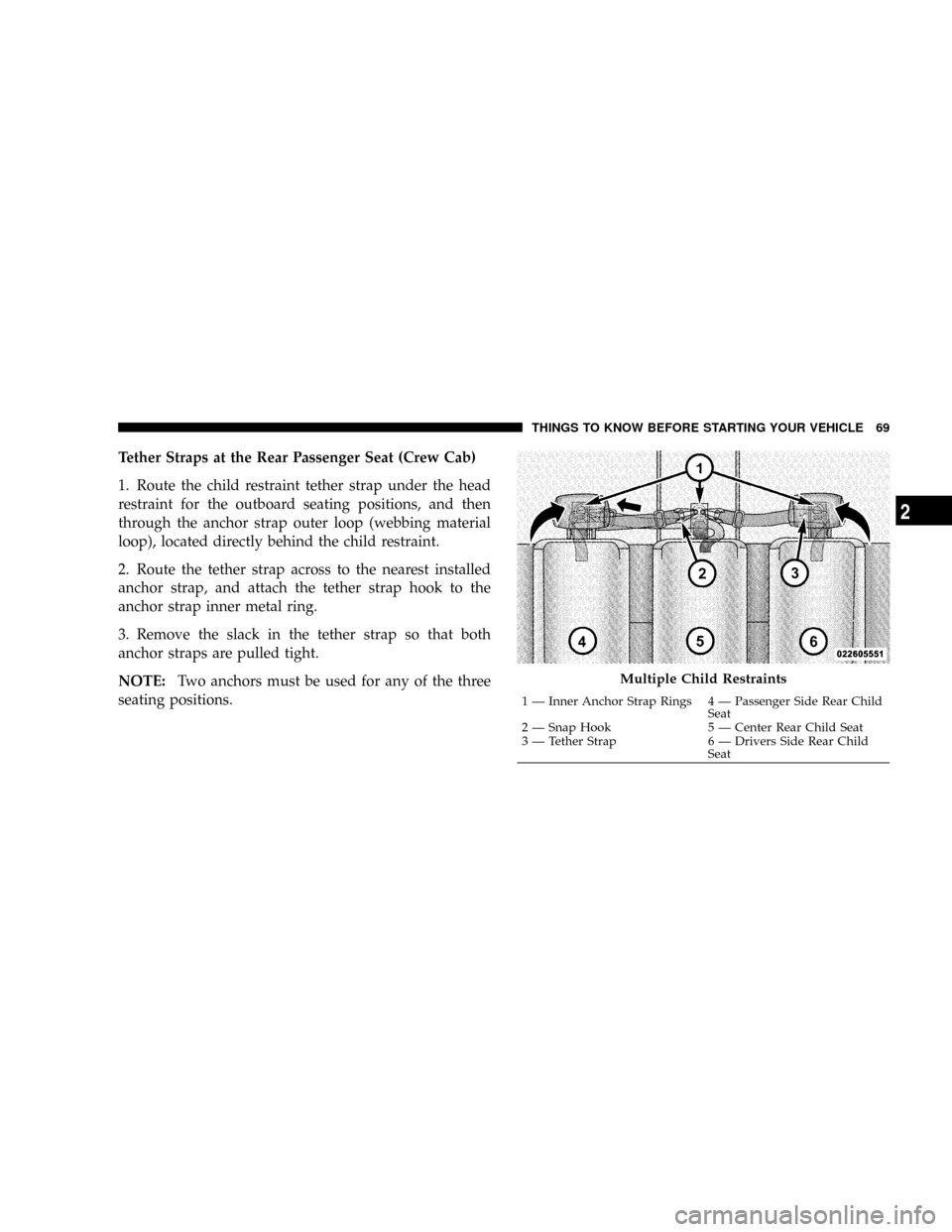
Tether Straps at the Rear Passenger Seat (Crew Cab)
1. Route the child restraint tether strap under the head
restraint for the outboard seating positions, and then
through the anchor strap outer loop (webbing material
loop), located directly behind the child restraint.
2. Route the tether strap across to the nearest installed
anchor strap, and attach the tether strap hook to the
anchor strap inner metal ring.
3. Remove the slack in the tether strap so that both
anchor straps are pulled tight.
NOTE:Two anchors must be used for any of the three
seating positions.
Multiple Child Restraints
1 Ð Inner Anchor Strap Rings 4 Ð Passenger Side Rear Child
Seat
2 Ð Snap Hook 5 Ð Center Rear Child Seat
3 Ð Tether Strap 6 Ð Drivers Side Rear Child
Seat THINGS TO KNOW BEFORE STARTING YOUR VEHICLE 69
2
Page 72 of 449
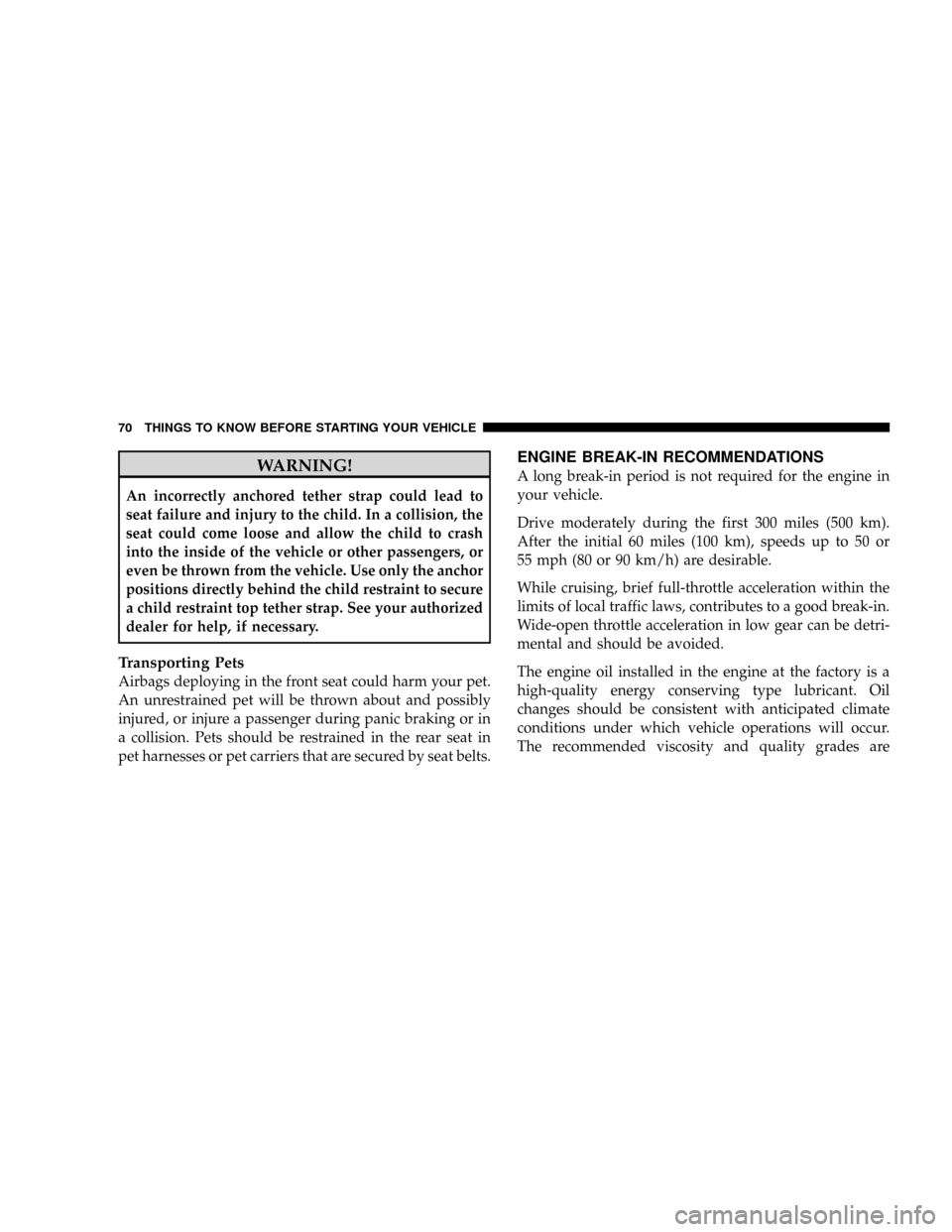
WARNING!
An incorrectly anchored tether strap could lead to
seat failure and injury to the child. In a collision, the
seat could come loose and allow the child to crash
into the inside of the vehicle or other passengers, or
even be thrown from the vehicle. Use only the anchor
positions directly behind the child restraint to secure
a child restraint top tether strap. See your authorized
dealer for help, if necessary.
Transporting Pets
Airbags deploying in the front seat could harm your pet.
An unrestrained pet will be thrown about and possibly
injured, or injure a passenger during panic braking or in
a collision. Pets should be restrained in the rear seat in
pet harnesses or pet carriers that are secured by seat belts.
ENGINE BREAK-IN RECOMMENDATIONS
A long break-in period is not required for the engine in
your vehicle.
Drive moderately during the first 300 miles (500 km).
After the initial 60 miles (100 km), speeds up to 50 or
55 mph (80 or 90 km/h) are desirable.
While cruising, brief full-throttle acceleration within the
limits of local traffic laws, contributes to a good break-in.
Wide-open throttle acceleration in low gear can be detri-
mental and should be avoided.
The engine oil installed in the engine at the factory is a
high-quality energy conserving type lubricant. Oil
changes should be consistent with anticipated climate
conditions under which vehicle operations will occur.
The recommended viscosity and quality grades are
70 THINGS TO KNOW BEFORE STARTING YOUR VEHICLE
Page 73 of 449
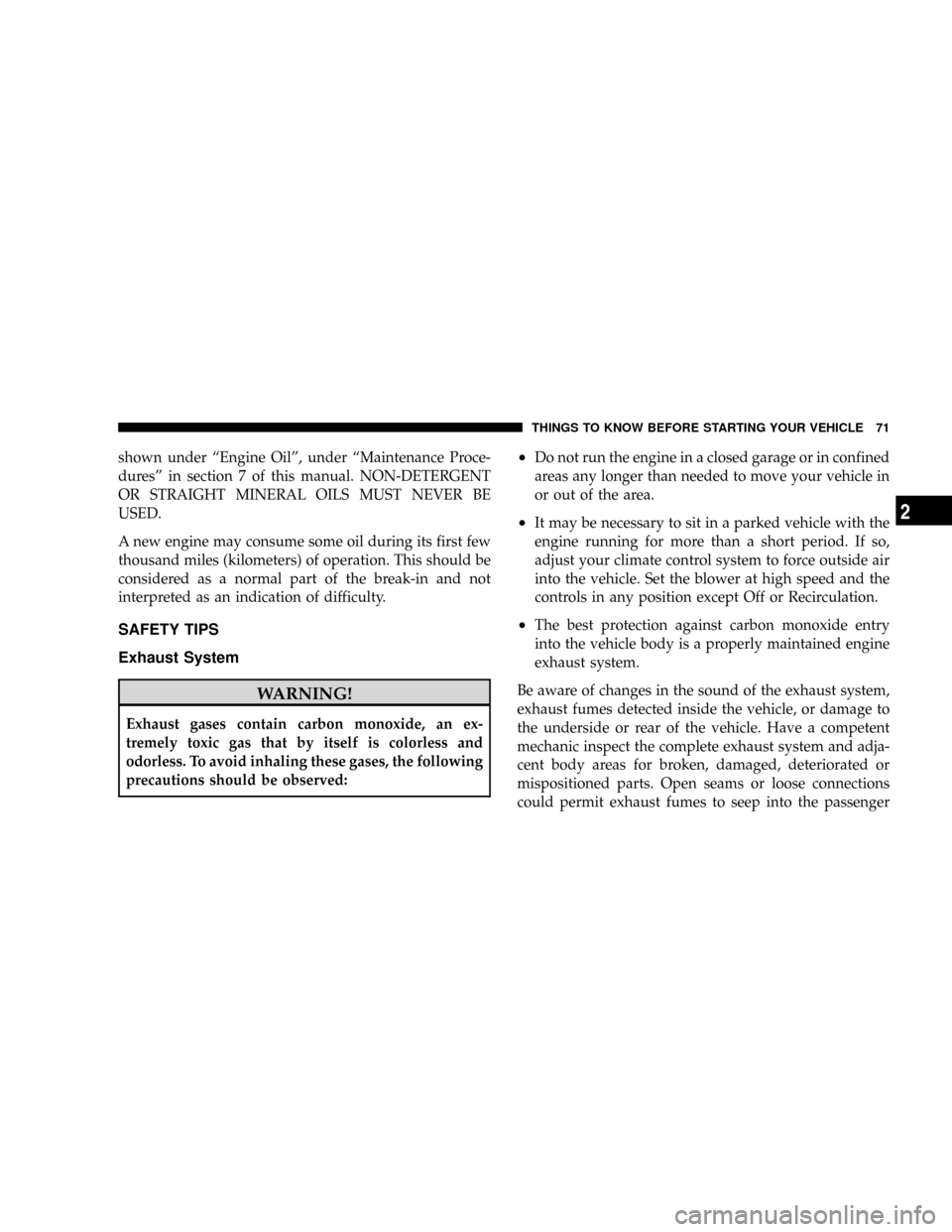
shown under ªEngine Oilº, under ªMaintenance Proce-
duresº in section 7 of this manual. NON-DETERGENT
OR STRAIGHT MINERAL OILS MUST NEVER BE
USED.
A new engine may consume some oil during its first few
thousand miles (kilometers) of operation. This should be
considered as a normal part of the break-in and not
interpreted as an indication of difficulty.
SAFETY TIPS
Exhaust System
WARNING!
Exhaust gases contain carbon monoxide, an ex-
tremely toxic gas that by itself is colorless and
odorless. To avoid inhaling these gases, the following
precautions should be observed:
²Do not run the engine in a closed garage or in confined
areas any longer than needed to move your vehicle in
or out of the area.
²It may be necessary to sit in a parked vehicle with the
engine running for more than a short period. If so,
adjust your climate control system to force outside air
into the vehicle. Set the blower at high speed and the
controls in any position except Off or Recirculation.
²The best protection against carbon monoxide entry
into the vehicle body is a properly maintained engine
exhaust system.
Be aware of changes in the sound of the exhaust system,
exhaust fumes detected inside the vehicle, or damage to
the underside or rear of the vehicle. Have a competent
mechanic inspect the complete exhaust system and adja-
cent body areas for broken, damaged, deteriorated or
mispositioned parts. Open seams or loose connections
could permit exhaust fumes to seep into the passenger
THINGS TO KNOW BEFORE STARTING YOUR VEHICLE 71
2
Page 74 of 449
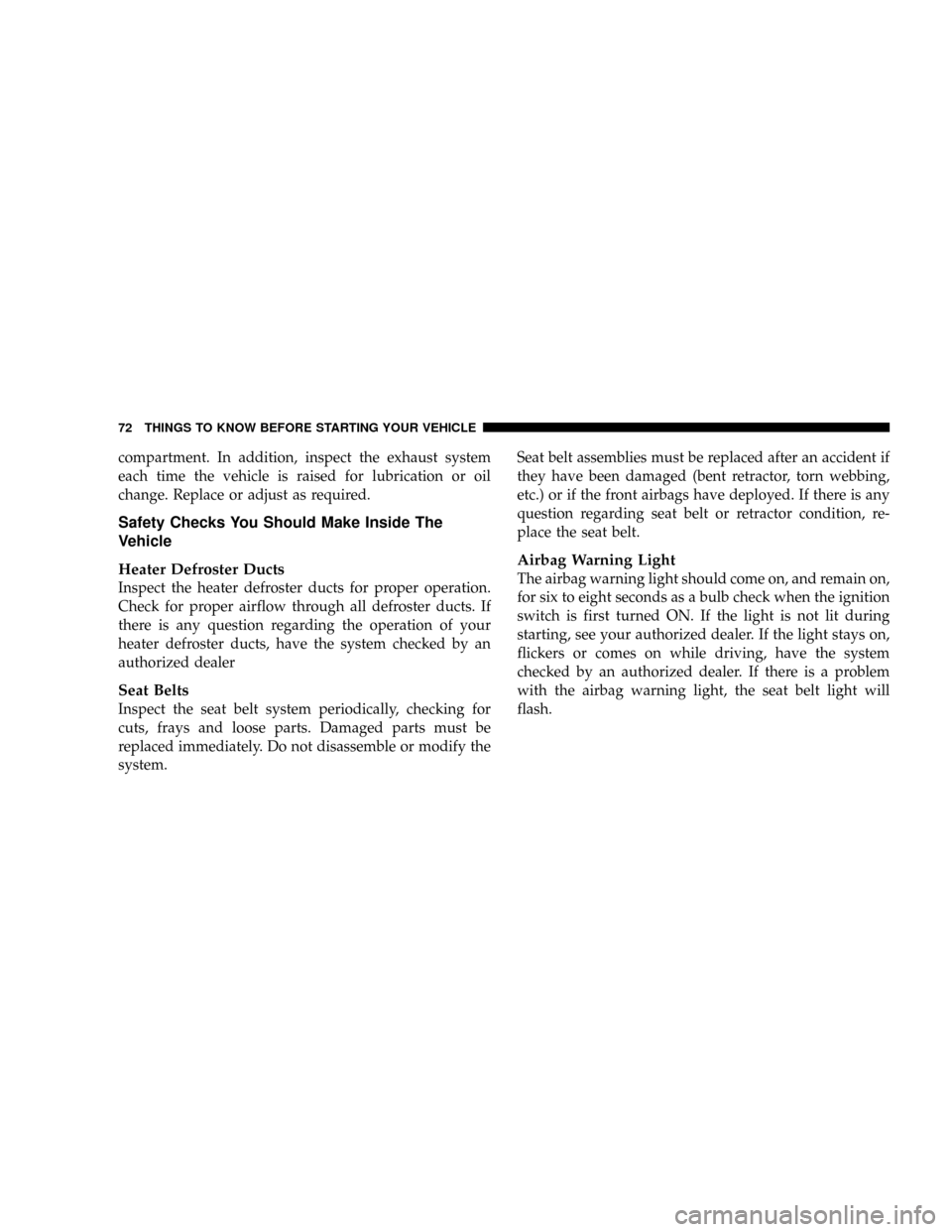
compartment. In addition, inspect the exhaust system
each time the vehicle is raised for lubrication or oil
change. Replace or adjust as required.
Safety Checks You Should Make Inside The
Vehicle
Heater Defroster Ducts
Inspect the heater defroster ducts for proper operation.
Check for proper airflow through all defroster ducts. If
there is any question regarding the operation of your
heater defroster ducts, have the system checked by an
authorized dealer
Seat Belts
Inspect the seat belt system periodically, checking for
cuts, frays and loose parts. Damaged parts must be
replaced immediately. Do not disassemble or modify the
system.Seat belt assemblies must be replaced after an accident if
they have been damaged (bent retractor, torn webbing,
etc.) or if the front airbags have deployed. If there is any
question regarding seat belt or retractor condition, re-
place the seat belt.
Airbag Warning Light
The airbag warning light should come on, and remain on,
for six to eight seconds as a bulb check when the ignition
switch is first turned ON. If the light is not lit during
starting, see your authorized dealer. If the light stays on,
flickers or comes on while driving, have the system
checked by an authorized dealer. If there is a problem
with the airbag warning light, the seat belt light will
flash.
72 THINGS TO KNOW BEFORE STARTING YOUR VEHICLE
Page 75 of 449
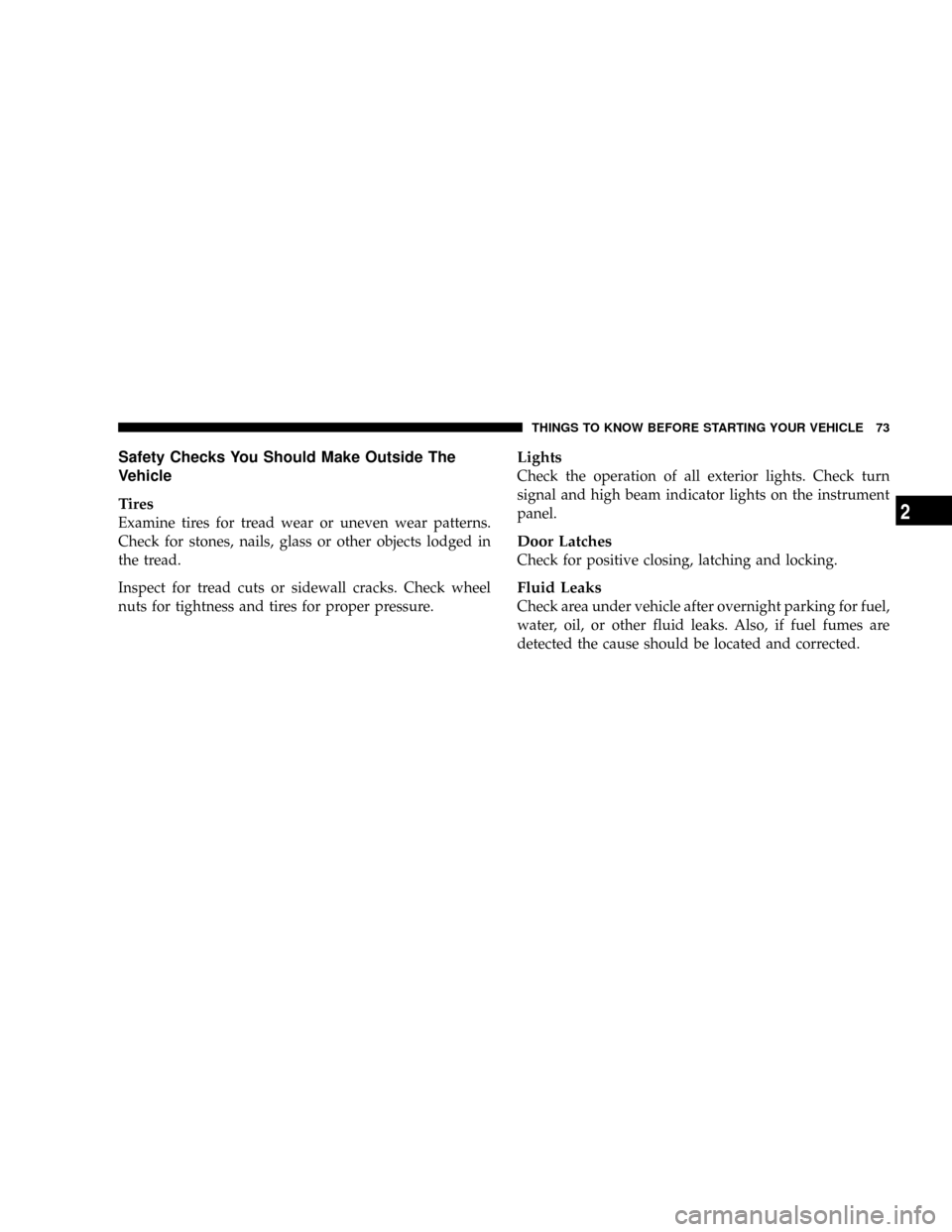
Safety Checks You Should Make Outside The
Vehicle
Tires
Examine tires for tread wear or uneven wear patterns.
Check for stones, nails, glass or other objects lodged in
the tread.
Inspect for tread cuts or sidewall cracks. Check wheel
nuts for tightness and tires for proper pressure.
Lights
Check the operation of all exterior lights. Check turn
signal and high beam indicator lights on the instrument
panel.
Door Latches
Check for positive closing, latching and locking.
Fluid Leaks
Check area under vehicle after overnight parking for fuel,
water, oil, or other fluid leaks. Also, if fuel fumes are
detected the cause should be located and corrected.
THINGS TO KNOW BEFORE STARTING YOUR VEHICLE 73
2
Page 76 of 449

Page 77 of 449
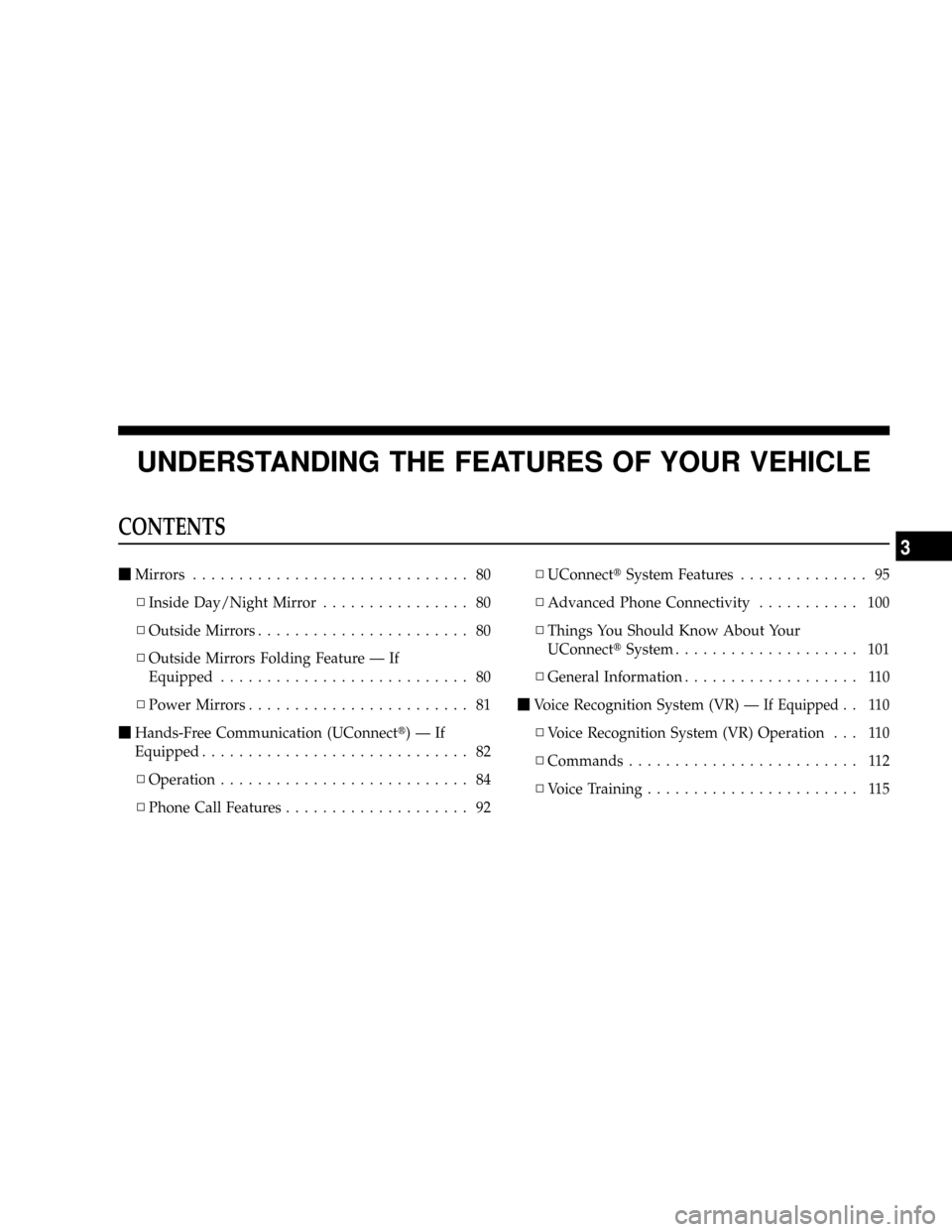
UNDERSTANDING THE FEATURES OF YOUR VEHICLE
CONTENTS
mMirrors.............................. 80
NInside Day/Night Mirror................ 80
NOutside Mirrors....................... 80
NOutside Mirrors Folding Feature Ð If
Equipped........................... 80
NPower Mirrors........................ 81
mHands-Free Communication (UConnectt)ÐIf
Equipped............................. 82
NOperation........................... 84
NPhone Call Features.................... 92NUConnecttSystem Features.............. 95
NAdvanced Phone Connectivity........... 100
NThings You Should Know About Your
UConnecttSystem.................... 101
NGeneral Information................... 110
mVoice Recognition System (VR) Ð
If Equipped.. 110
NVoice Recognition System (VR) Operation . . . 110
NCommands......................... 112
NVoice Training....................... 115
3
Page 78 of 449
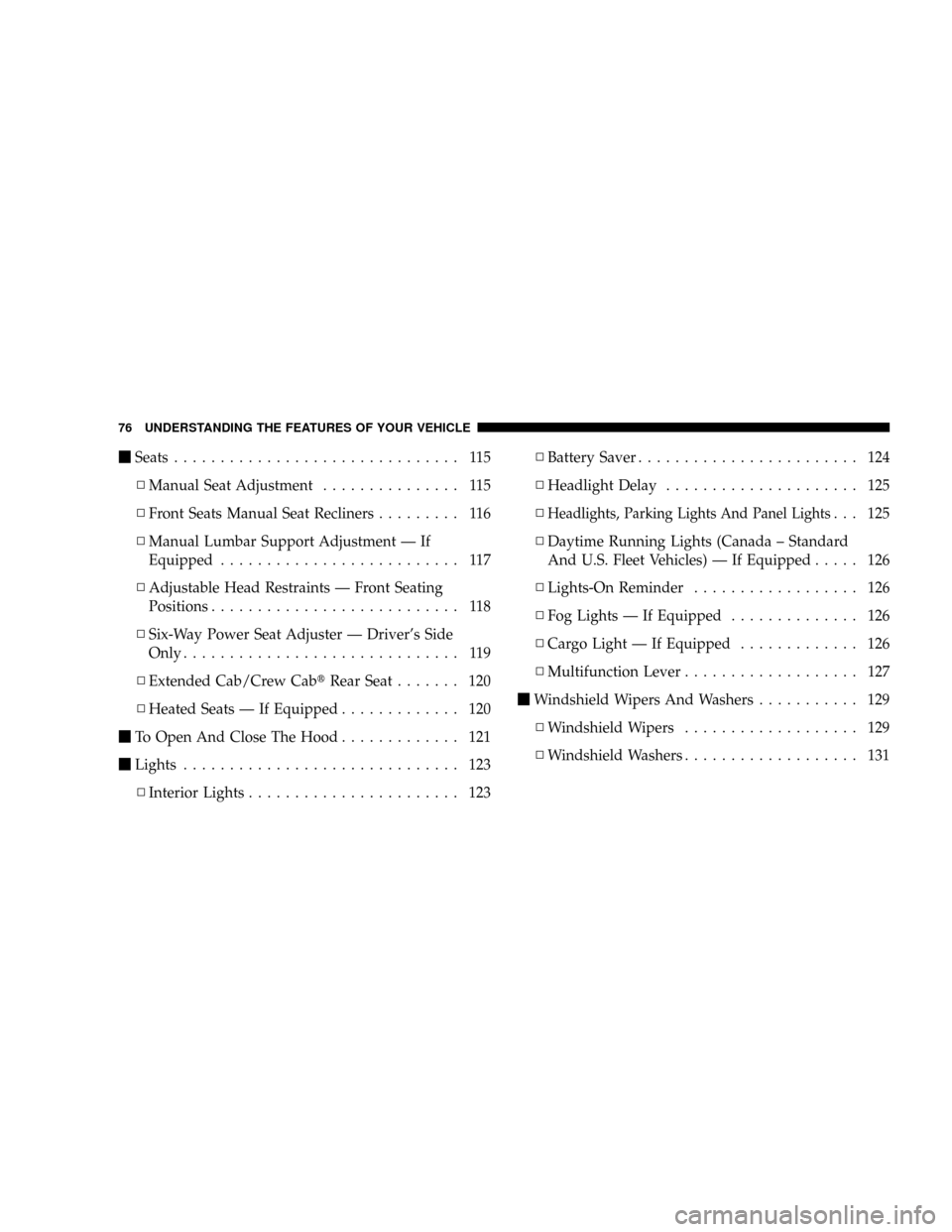
mSeats............................... 115
NManual Seat Adjustment............... 115
NFront Seats Manual Seat Recliners......... 116
NManual Lumbar Support Adjustment Ð If
Equipped.......................... 117
NAdjustable Head Restraints Ð Front Seating
Positions........................... 118
NSix-Way Power Seat Adjuster Ð Driver's Side
Only.............................. 119
NExtended Cab/Crew CabtRear Seat....... 120
NHeated Seats Ð If Equipped............. 120
mTo Open And Close The Hood............. 121
mLights.............................. 123
NInterior Lights....................... 123NBattery Saver........................ 124
NHeadlight Delay..................... 125
N
Headlights, Parking Lights And Panel Lights... 125
NDaytime Running Lights (Canada ± Standard
And U.S. Fleet Vehicles) Ð If Equipped..... 126
NLights-On Reminder.................. 126
NFog Lights Ð If Equipped.............. 126
NCargo Light Ð If Equipped............. 126
NMultifunction Lever................... 127
mWindshield Wipers And Washers........... 129
NWindshield Wipers................... 129
NWindshield Washers................... 131
76 UNDERSTANDING THE FEATURES OF YOUR VEHICLE
Page 79 of 449
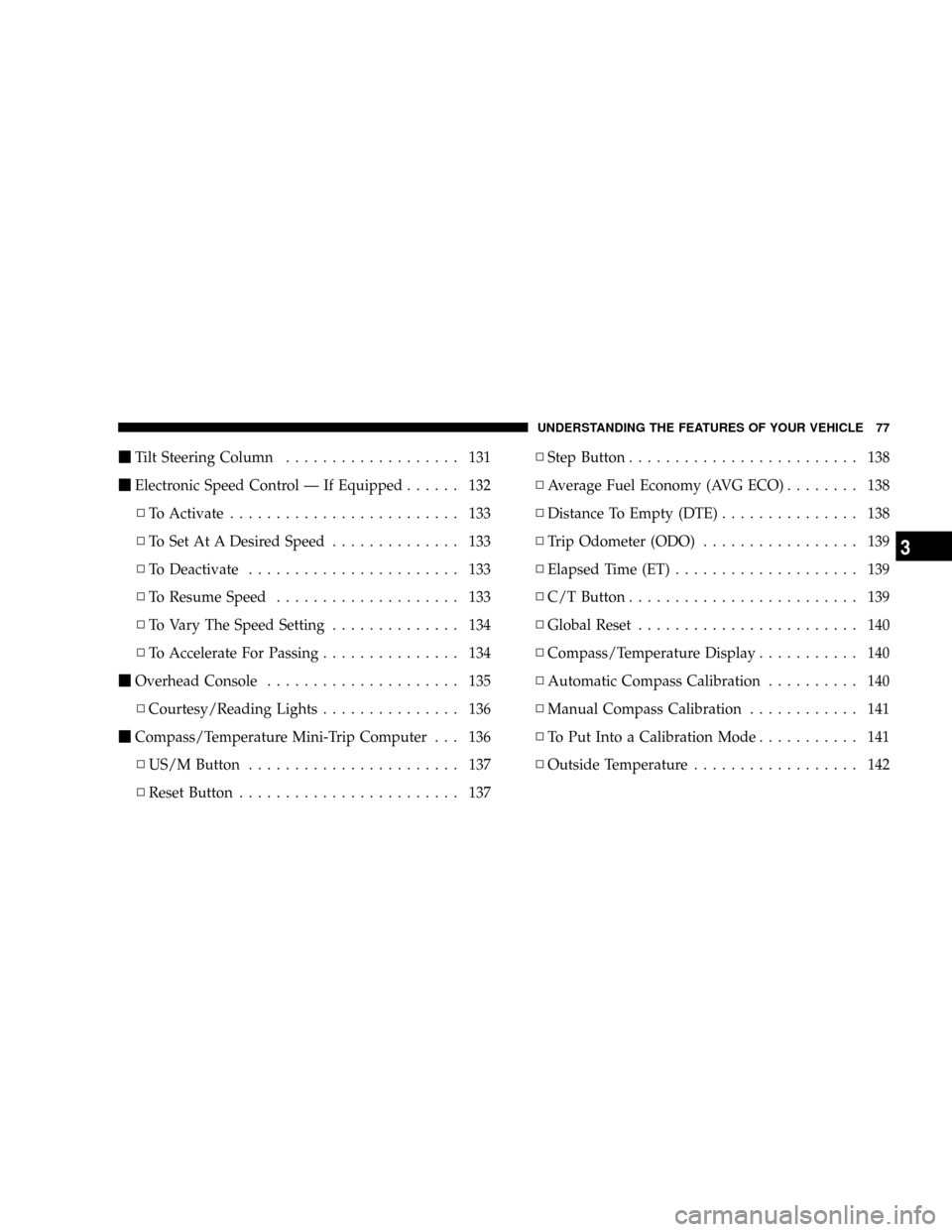
mTilt Steering Column................... 131
mElectronic Speed Control Ð If Equipped...... 132
NTo Activate......................... 133
NTo Set At A Desired Speed.............. 133
NTo Deactivate....................... 133
NTo Resume Speed.................... 133
NTo Vary The Speed Setting.............. 134
NTo Accelerate For Passing............... 134
mOverhead Console..................... 135
NCourtesy/Reading Lights............... 136
mCompass/Temperature Mini-Trip Computer . . . 136
NUS/M Button....................... 137
NReset Button........................ 137NStep Button......................... 138
NAverage Fuel Economy (AVG ECO)........ 138
NDistance To Empty (DTE)............... 138
NTrip Odometer (ODO)................. 139
NElapsed Time (ET).................... 139
NC/T Button......................... 139
NGlobal Reset........................ 140
NCompass/Temperature Display........... 140
NAutomatic Compass Calibration.......... 140
NManual Compass Calibration............ 141
NTo Put Into a Calibration Mode........... 141
NOutside Temperature.................. 142
UNDERSTANDING THE FEATURES OF YOUR VEHICLE 77
3
Page 80 of 449
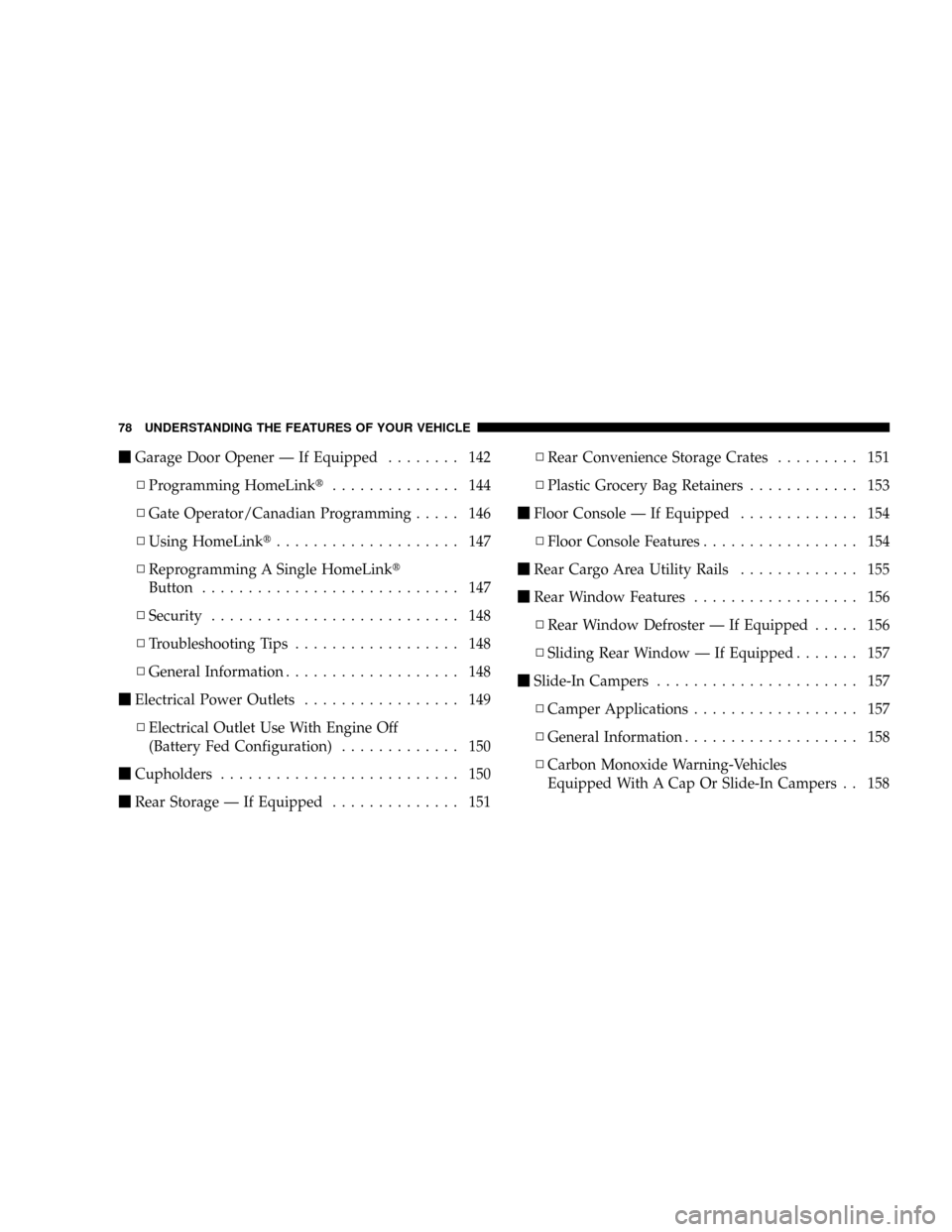
mGarage Door Opener Ð If Equipped........ 142
NProgramming HomeLinkt.............. 144
NGate Operator/Canadian Programming..... 146
NUsing HomeLinkt.................... 147
NReprogramming A Single HomeLinkt
Button............................ 147
NSecurity........................... 148
NTroubleshooting Tips.................. 148
NGeneral Information................... 148
mElectrical Power Outlets................. 149
NElectrical Outlet Use With Engine Off
(Battery Fed Configuration)............. 150
mCupholders.......................... 150
mRear Storage Ð If Equipped.............. 151NRear Convenience Storage Crates......... 151
NPlastic Grocery Bag Retainers............ 153
mFloor Console Ð If Equipped............. 154
NFloor Console Features................. 154
mRear Cargo Area Utility Rails............. 155
mRear Window Features.................. 156
NRear Window Defroster Ð If Equipped..... 156
NSliding Rear Window Ð If Equipped....... 157
mSlide-In Campers...................... 157
NCamper Applications.................. 157
NGeneral Information................... 158
NCarbon Monoxide Warning-Vehicles
Equipped With A Cap Or Slide-In Campers . . 158
78 UNDERSTANDING THE FEATURES OF YOUR VEHICLE